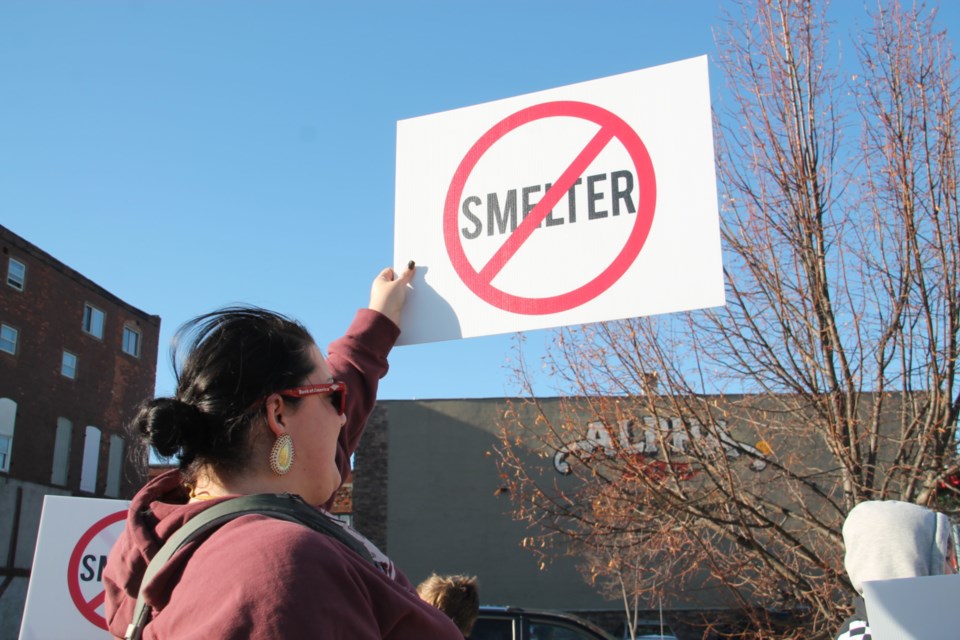Groups of environmentally concerned citizens gathered in the twin cities of Sault Ste. Marie – in Ontario, Canada and in Michigan, U.S. – on Nov. 23 for coordinated rallies to protest Noront Resources' planned ferrochrome production facility for Sault Ste. Marie, Ont.
“I know of people in Marquette, all over the state of Michigan, who are concerned about the building of this facility,” said James McCall, Sault Michigan resident, speaking to SooToday.
About 20 protesters gathered on the U.S. side at 1 p.m., intending to stay at that location until 6 p.m., the group including professional environmentalists and members of the Sault Tribe of Chippewa Indians.
“Today’s event is all about the U.S. side’s opposition to the building of the ferrochrome smelter. The probability of it being built is high at the moment. From my understanding of ferrochrome and the smelting process, it’s worse than asbestos and lead put together,” McCall said.
“It’s a major carcinogen. It’s bad. There shouldn’t be any processing plants on the St. Mary's River, bordering any water source on the Great Lakes.”
“We’re people from all walks of life, coming together for this purpose. We’re going to be standing here to raise awareness, because I was surprised at the number of people (in Sault Michigan and area) who had no idea of what is being planned over there in Sault, Ont.,” said Tomantha Sylvester, a Sault Michigan resident and Sault Tribe member.
“People are free to ask us questions as they walk by. That’s what we’re here for, and to stand in solidarity with our friends in Sault, Ontario.”
“I think it’s very powerful (that people from the twin Saults are banding together to protest Noront’s plans),” Sylvester said.
“I think it goes to show we have strength in numbers, that there are people aware of it and don’t agree with what’s being planned. It’s harmful for our water sources. It’s been proven chromium contaminates everything it touches...we should be listening to the scientists and the doctors who say this is bad. I’m not perfect. I drive a car, I add to pollution, but this is on a different level.”
Both Sylvester and McCall said they are skeptical of Noront’s consultation process.
In Sault, Ontario, a group of approximately 30 people gathered to protest on the waterfront boardwalk next to the Delta Hotel, intending to get their message across between 1 p.m. and 3 p.m.
“We’re concerned about the water, the air, the soil and the pollution that can come with this. They’re telling us there’s new technology, but it hasn’t been tried before and there are no guarantees with this kind of stuff and we’re very worried about it,” said Yvette Leonard.
“We’re not opposed to business, but we are opposed to business which is going to be detrimental to our health and our environment.”
“I don’t want the smelter here. We’re like guinea pigs (for Noront). That’s not acceptable. This is a beautiful area. We can bring other businesses here that don’t cause damage,” Leonard said.
As for the Sault, Michigan protest, Leonard said, “It shows it scares a lot of people. It’s international. They don’t want it, we don’t want it, so we’re standing in solidarity to oppose it.”
Noront Resources announced May 7 it had chosen Sault Ste. Marie, Ont., to be its site of choice for a ferrochrome production facility.
The facility, to be located near Algoma Steel in the city's west end, will process chrome ore from deposits Noront will be drawing from the Ring of Fire region to be converted into ferrochrome for the U.S. stainless steel market.
Noront estimates construction of the ferrochrome production facility will begin in 2025, and the plant will be up and running by 2028.
During construction, the project will employ up to 1,500 people, and once in operation, employ 300 to 500 people.
This story originally appeared on SooToday.com.




